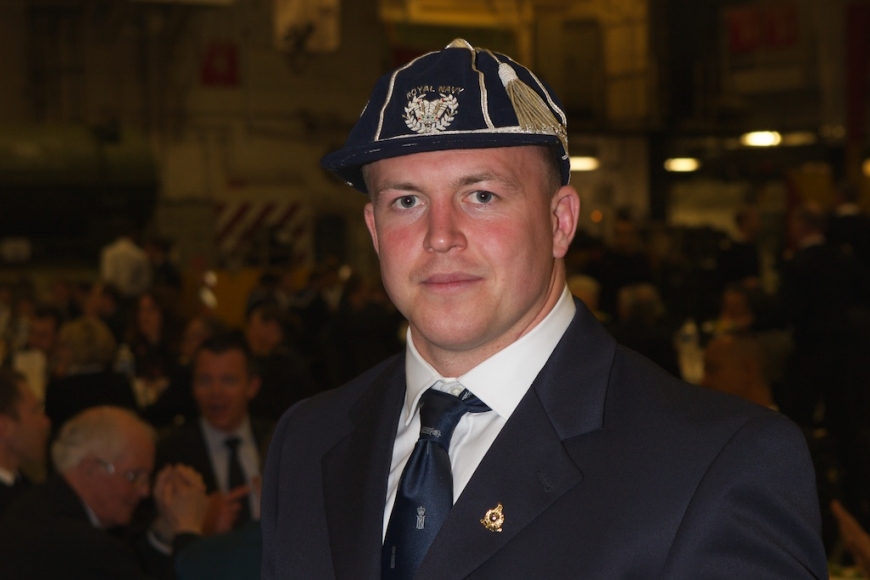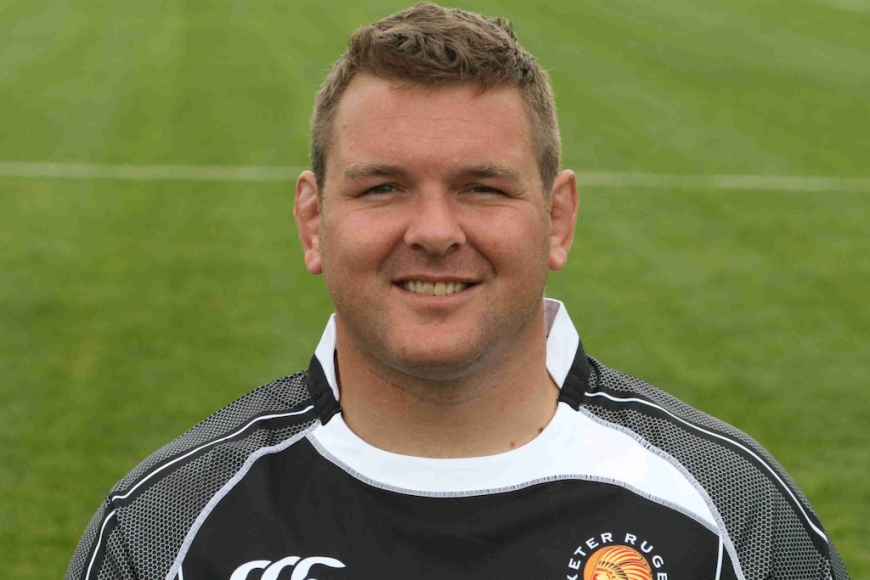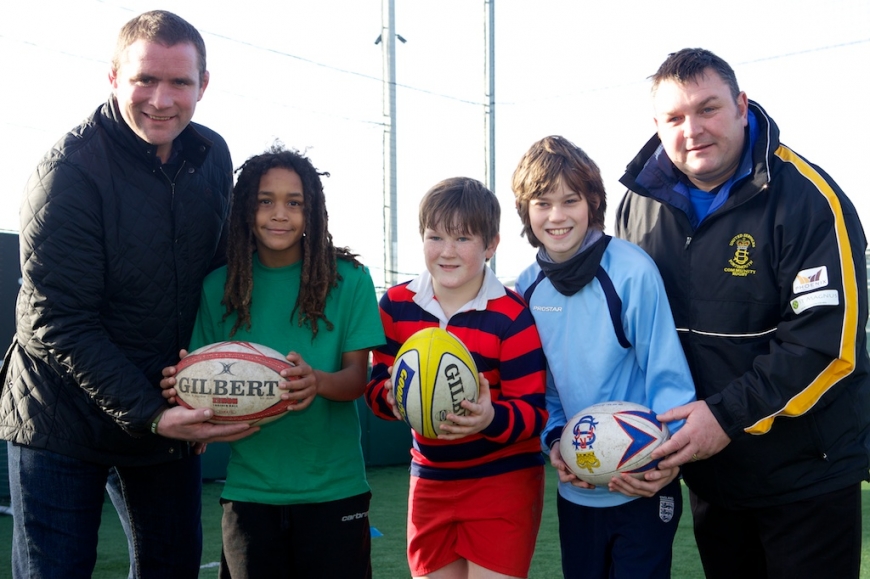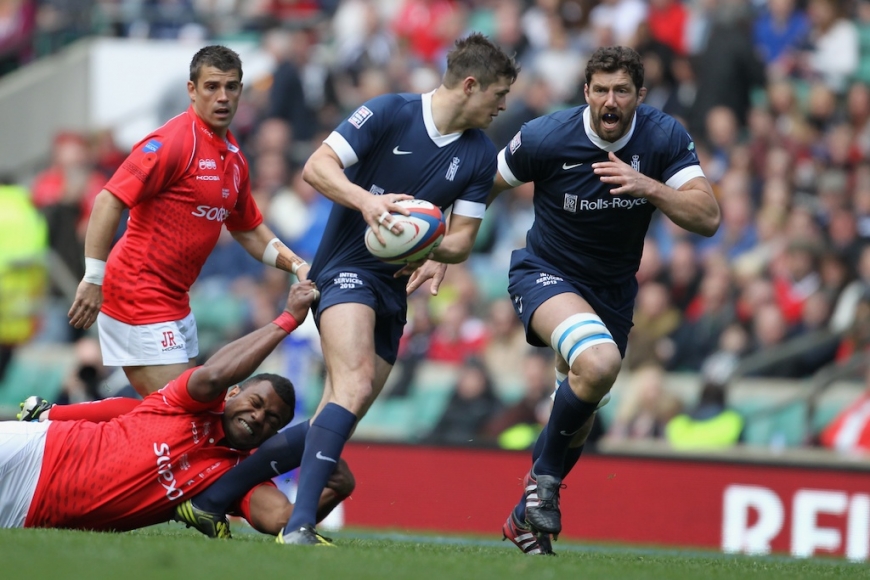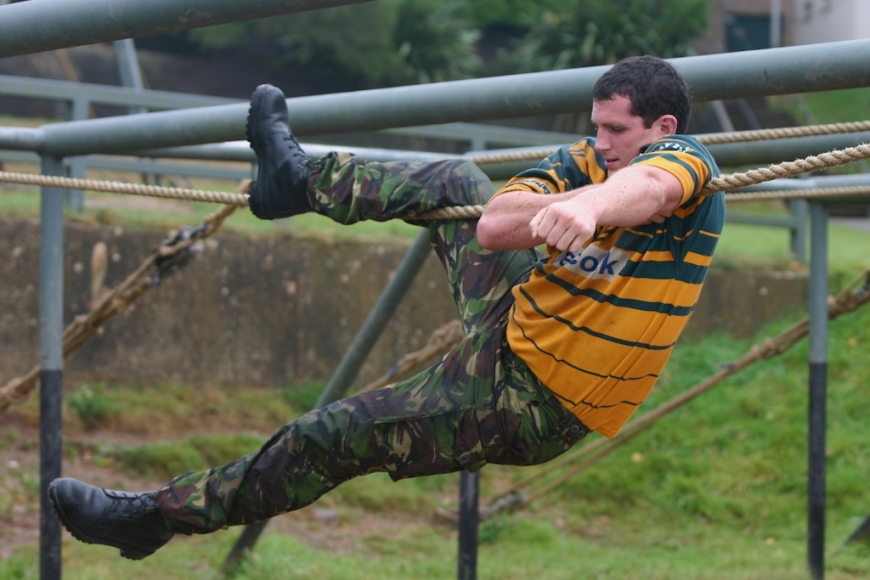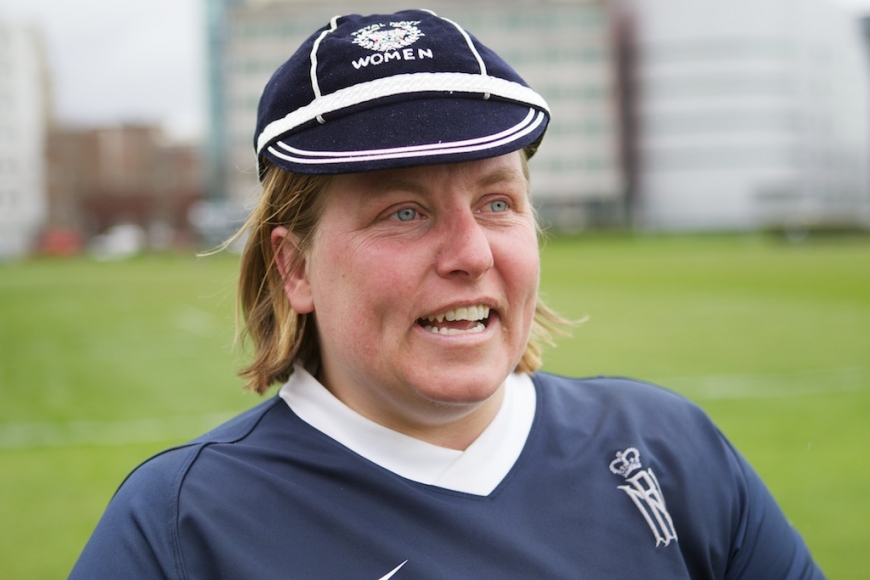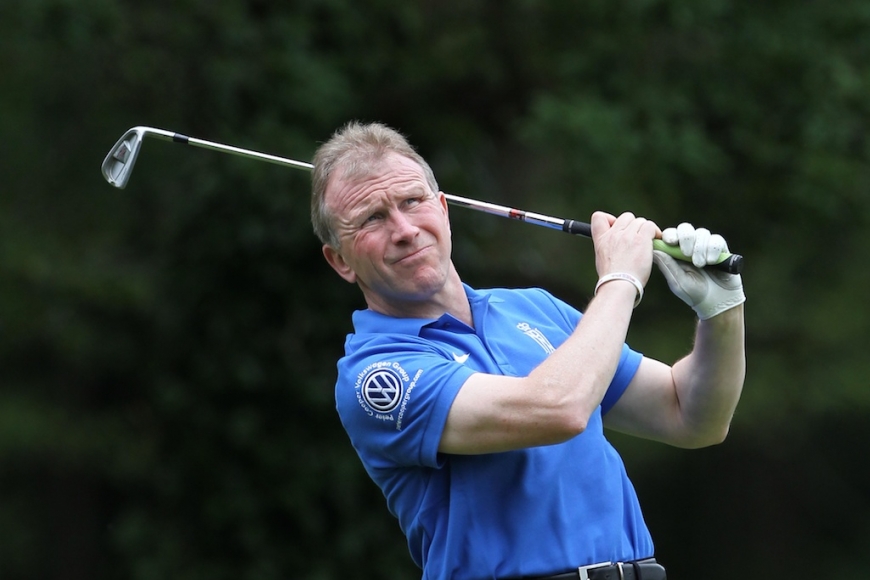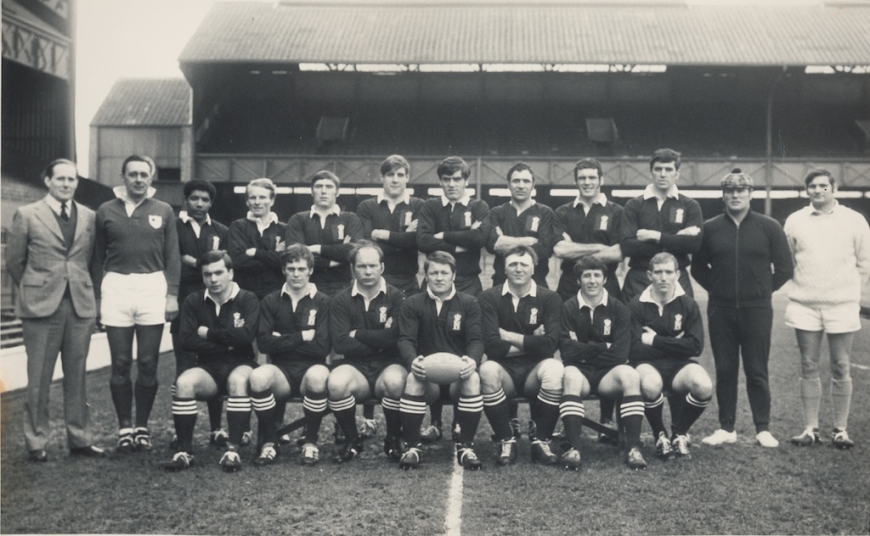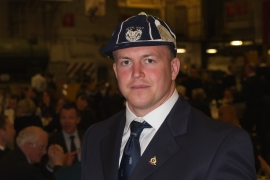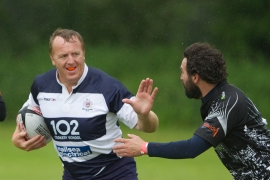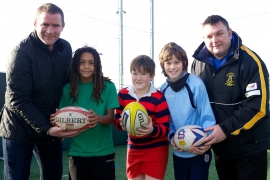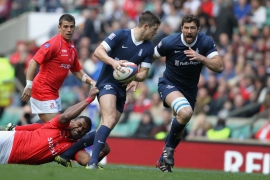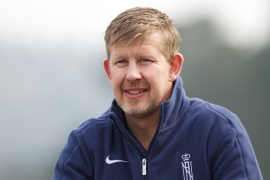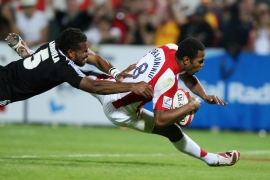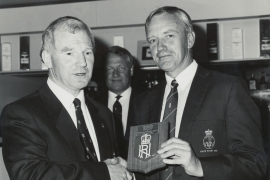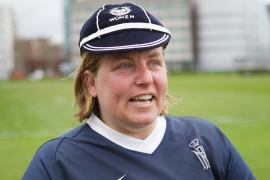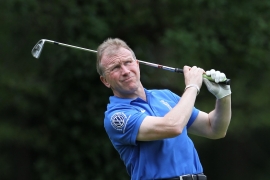If Experience Counts

Currently 714 men and 17 women have been capped by the Royal Navy Rugby Union. The newest cap is Maltese International Harry Collins but what would a team look like picked from the most capped players to have represented the Union?
Frequently, when World Cup winning rugby teams are spoken about, the importance of experience is mentioned. The minimum number of caps required within the team is debated and the statistics of previous World Cup winning teams are reported. The issue of ‘number of caps’ is currently a hot topic within Navy Rugby with two great stalwarts, Bob Armstrong and Dave Pascoe, tied on 31 caps as the Royal Navy Rugby Union’s most capped players. So what would a Royal Navy rugby team look like if you picked the most experienced players by position?

Bob Armstrong won 31 caps in a sixteen-year career. From his first cap against the RAF in 1989 he did not miss an Inter Service match until his last match, against the Army in 2004. He played at Number 8, blindside flanker and the second row for the Royal Navy.
The front row brings together Dan Parkes, William Luddington and John Ackerman with replacements of Nick Bartlett, Glyn Thomas and Si Burns. Dan is the most capped Navy prop of all time, who won representative honours with England Students and England Counties. Very much a modern day prop; mobile and comfortable with ball in hand he would prove to be the perfect counter foil to John Ackerman at tight head. John was probably the best technical prop in recent generations to have worn the Navy shirt. His back as level as a billiard table, he would be guaranteed to anchor the scrum, providing the platform from which so much of the game depends. Between them, William Luddington, at hooker; more of him later.

There are a number of distinguished Navy props amongst the most capped players of the RNRU but Dan with 23 caps heads the list. Standing out in a bright white scrum cap he very nearly finished his career in style during the 2007 match v the RAF. A 50m break deserved the reward of a try but the aging legs gave way just before the line was reached. Image courtesy of Dan Parkes
When the starting front row tires the replacements are equally adept. Bartlett, Thomas and Burns would prove to be a very different front row. Far more squat they would get under the opposition and also under their skin. All of them feisty when required, they epitomise the traditions of Naval forward play, uncomplicated, uncomplaining, uncompromising. In Si Burns they also have the Navy’s longest serving player. Alongwith Bob Armstrong, Si Burns shares the honour of having a capped playing career of sixteen seasons. Quite some achievement.

Two very distinguished props. Si Burns in his current US Portsmouth RFC role and Phil Vickery encourage the next generation of rugby players.
At lock there are two second rows both on sixteen caps. Tom Jones, who debuted in 1957 makes the starting XV with Del Cross ready and able as the perfect replacement. Alongside them, is by far the Navy’s most capped lock, Marsh Cormack. Any of the three would give the Navy a great lineout presence. In Tom’s day the locks were not expected to cover quite so much ground, as today, but he was an excellent all round player and was well versed in the laws of the jungle, that governed the lineout in the days before lifting was allowed.

Marsh Cormack is the Navy’s most capped lock forward whose contribution to Service rugby was recognised with his selection for the 2008 Help for Heroes International Charity match at Twickenham. He also played in the 2011 H4H match; this time during a few days break from his Operational Tour in Afghanistan.
In the backrow Bob Armstrong is moved across to six to allow Gaz Evans to play at Number 8. Bob provides the strong ball carrying ability required and also gives an added edge to the Navy’s maul. Gaz, another strong ball carrier but with a style ideally suited to broken play, would certainly provide the perfect foil to the two wingers chosen when the Navy looked to counter attack. Completing the trio is Roger Godfrey whose style of play is sadly missing from the modern game. Soft hands and good vision the old fashion openside flanker, providing the link between forwards and backs in attack and ever willing to scythe down opponents in defence. Able to cover all three backrow positions is Matt Parker, who makes the replacement bench; his strong play over the ball would ensure the good supply of turnover possession towards the end of the game.

Gaz Evans has played at Number 8, hooker and tight head prop for the Royal Navy. He scored the winning try the last time the Inter Service title was claimed and is known for his strong running game, particularly from the backfield. Prior to the 2009 Commonwealth Cup he was also keen to show he still had all his Commando skills.
The four halfbacks that make the team are certainly contrasts. Starting the match are the two Dave’s – Pascoe and Sibson. Both very strong, physical players who read and understand the game well. They would certainly keep any opposition backrow honest in defence and ensure that space is maintained wide out. Once the opposition have been softened up by the heavy bombardment of Pascoe and Sibson then they could be replaced by the livewire Paul Livingstone and the majestic WJA ‘Dicky’ Davies. Paul’s sniping around the fringes would be perfect to exploit tiring defence, in the latter stages of the match, and Davies would profit from the time afforded by his quick service. WJA Davies is the junior of the side, with only 11 caps, albeit his thirteen seasons included the Great War. Described by many as England’s greatest ever fly half (yes Jonny Wilkinson included) Davies would ensure that the Royal Navy could close the game out in style during the final quarter.

Dave Sibson with 22 caps served the Union with distinction at centre and fly half and is still involved as a player with the Mariners. He came to prominence in 1993 when wearing the white shirt of Combined Services. He produced an impressive defencive display against the touring All Blacks at Devonport Services. Bob Armstong was the only other Navy representative that famous evening when New Zealand had to work very hard for their 13-3 victory
The back five provides a perfect blend of rapier and cutlass. Starting the game, the low centre of gravity and direct running of David Hambrock would get over the gain line, as would the powerful, abrasive running of Geoff Fabian from full back. Both robust abrasive players whose contribution would create vital space for others. Chris Alcock, at outside centre, had the vision to exploit this space and in Spencer Brown and Josh Drauniniu he would have two international wingers who knew how to score tries. From the bench Mike Pearey’s smooth running style would ghost through space but he also had the ability to time a pass to perfection, a skill that has stood the test of time and can still unpick the fastest of rush defences.

Josh Drauniniu became a Navy crowd favourite from very early on in his playing career. An England Sevens international his balanced running produced a host of memorable tries, none more so than the brace he bagged at Twickenham in 2007 © Getty Images
An exciting group of twenty three players imbued with the traditions of Navy Rugby. A team able to play in a number of styles. Forceful up front but with forwards comfortable with ball in hand. Creative and exciting in the three quarters but with backs prepared to front up if the game demands. However for completeness it needs an appropriate management team to bring them all together.

Chris Alcock now avoids contact sport for more gentle pursuits. He was captain of the side when Bob Armstrong won his first cap and until over taken by Dave Pascoe was the Union’s longest serving captain. Along with Mike Pearey, Chris has been a player, captain, Selector and Chairman of the Royal Navy Rugby Union.
The position of Selector is easy to fill; Ernest Roberts. Not only was Roberts the first Selector but he was also the Navy’s longest serving Selector having been asked to fill the role on four separate occasions between 1911 – 1928, he also chaired selection from 1908 – 1911. He was captain in the first capped game and was also one of the first Life Member’s of the Union.

The plaque commemorating the contribution of Ernest Roberts to the Royal Navy Rugby Union on display in US Portsmouth’s club house. A similar one is on display in Devonport Services. The first Selector for the Royal Navy, a role he fulfilled on four separate occasions.
To support him in the role the choice of captain is equally important and there are many to chose from within the starting XV. Parkes, Jones, Armstrong, Godfrey, Pascoe and Alcock all captained the Union with distinction during their playing careers. However lets turn to William Luddington, a goal kicking prop and or hooker who starred for both England and the Royal Navy before being killed in action during the Second World War. Why Luddington? William Luddington was clearly a special player but was also the first ever Rating to captain the Royal Navy Rugby Union. Considering the resistance the committee of the day made to Ratings being allowed to be selected for the Navy, to be made captain so soon after clearly shows the respect and leadership qualities Luddington had; as a consequence he would be an ideal man to lead from the front. He would also be the team kicker as his winning touchline conversion in the 1923 Calcutta International proves his temperament and ability under pressure.
![] William Luddington, back row far left, at Twickenham before the 1924 Calcutta Match between England and Scotland](https://www.navyrugbyunion.co.uk../assets/galleries/org_13964142281474189221.jpg)
William Luddington, back row far left, at Twickenham before the 1924 Calcutta Match between England and Scotland. The Royal Navy Rugby Union’s first captain not drawn from the Officer Corps was killed in action when serving on board HMS Illustrious in 1942. Image source unknown.
Fortunately the team selected has a number of excellent administrators amongst its ranks. Mike Pearey went on to become President of the Rugby Football Union and Roger Godfrey one of the RFU’s most respected administrators. With a ‘schoolie’ at hooker, the match report is also taken care of. However a Team Manager is still required and to fill this role a slightly left field selection. Though only winning two caps, both in 1962, Peter Cunningham’s active contribution to the Union must be one of the longest, spanning five decades as player and active referee. The dinners he organised for the Referee’s Society are still fondly remembered and if, for no other reason, he makes the TSG with the remit to organise the after match dinner complete with Royal Marine Band ensemble.

Mike Pearey (left), one of many excellent administrators for the RNRU, went on to become President of the RFU. Binge Gatehouse is in the back ground on this picture, taken when touring Australia in 1986. Image courtesy of T Gatehouse
There are only two positions left to fill. A role now filled by highly qualified medical staff supplemented by coaches in radio communication to the Selector for the latest words of wisdom, the on field runner has changed from the days of a bucket, icy water and sponge. However the role has always had value and is one ideally suited to Trevor ‘Binge’ Gatehouse whose 14 caps marks him as ‘respected junior’ in the group. He makes the TSG for two reasons. First on the playing side whether for the Fleet Air Arm, the Royal Navy or the Combined Services he always led from the front and often ousted a more illustrious competitor for the hooking position. It is hard to think of a more competitive, ardent Navy rugby player more suited to bring on the occasional word of ‘encouragement’ at the appropriate time. And the second reason? Quite simply he would invite himself!

Trevor ‘Binge’ Gatehouse captain’s the Royal Navy in 1973. On his right is John Ackerman who makes the Select XV at prop. Image courtesy of T Gatehouse
On the other touchline is perhaps another surprising selection, Pam Williams-Wilson. Not only is Pam the most capped player for the Royal Navy Women but is another that lives and breathes the traditional values of the Royal Navy Rugby Union. Her playing contribution to the Women’s game over many years is reason enough to include her in the TSG as is her being one of only a few people who would be able to keep Binge in check!

Since 2011 the Royal Navy Women have also been eligible to become capped by the RNRU. A survivor from their first ever win in the Inter Services in 2005, Pam Williams-Wilson is their most capped player with 5.
Royal Navy Rugby Union ‘Most Capped” Select XV: Dan Parkes [23], William Luddington [16] ©, John Ackerman [20], Tom Jones [16], Marsh Cormack [23], Bob Armstrong [31], Roger Godfrey [16], Gaz Evans [19], Dave Pascoe [31], Dave Sibson [22], Spencer Brown [16], David Hambrook [16], Chris Alcock [19], Josh Drauniniu [15], Geoff Fabian [16]
Rpelacments: Glyn Thomas [16], Nick Bartlett [20], Si Burns [17], Del Cross [16], Matt Parker [15], Paul Livingstone [19], WJA Davies [11], Mike Pearey [15]
Postcript - Having looked once more at the characters that make selection and with a post match dinner planned there is a clear requirement for one more selection. Capped in 1948 and a try scorer against the RAF, the Union’s longest serving President should also be included; Admiral of the Fleet, the Lord Lewin – just in case top cover is required.
Article by Geraint Ashton Jones
Unless otherwise stated images by Alligin Photography / © Geraint Ashton Jones

